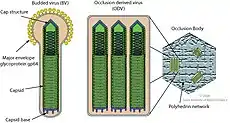Naldaviricetes
Naldaviricetes ist eine Klasse von Viren, die Arthropoden infizieren. Sie enthalten ein doppelsträngiges DNA-Genom, die Virionen (Viruspartikel) sind groß, von komplexer Morphologie und mit einer Virushülle.[3][4][1]
| Naldaviricetes | ||||||||||
|---|---|---|---|---|---|---|---|---|---|---|

Aufbau eines Virions der Nimaviridae | ||||||||||
| Systematik | ||||||||||
| ||||||||||
| Taxonomische Merkmale | ||||||||||
| ||||||||||
| Wissenschaftlicher Name | ||||||||||
| Naldaviricetes | ||||||||||
| Links | ||||||||||
|

Systematik
Die Klasse Naldaviricetes enthält mit Stand Juni 2021 eine Ordnung und eine Familie ohne Ordnungszuweisung. Diese Taxonomie wird im Folgenden dargestellt:[3][1]
Klasse: Naldaviricetes
- Ordnung: Lefavirales
- Familie: Baculoviridae
- Familie: Hytrosaviridae
- Familie: Nudiviridae
- ?Familie: Polydnaviridae (Vorschlag, s. u.)
- Familien ohne Ordnungszuweisung:
- Familie: Nimaviridae
Phylogenie
Bereits 2012/2013 gab es erste Hinweise, dass die Baculoviridae, Hytrosaviridae und Nudiviridae, vermutlich zusammen mit der Gattung Bracovirus der vermutet polyphyletischen Polydnaviridae[5] eine Verwandtschaftsgruppe (Klade) bilden.[6] Diese Annahmen wurden 2015 und nochmals 2019 von Eugene V. Koonin et al. bekräftigt.[7][8] Im 1. Halbjahr 2021 hat das ICTV diese Gruppe als Klasse Naldaviricetes (ohne die Polydnaviridae) offiziell anerkannt.[1] Frühere provisorische Bezeichnungen für diese Gruppe waren „Modul 6“ (Koonin et al.) oder „Weißflecken-Baculovirus-Komplex“ (wegen des Weißfleckensyndrom-Virus in der Familie Nimaviridae). Der vom Schweizer Institut für Bioinformatik (SIB) im engen Sinn gebrauchte Begriff “Baculo-like viruses” (nur Baculoviridae und Nudiviridae umfassend)[9] scheint von manchen Autoren in einem weiteren Sinn für diese gesamte Klasse Naldaviricetes oder jedenfalls für die Ordnung Lefavirales verwendet worden zu sein.
Die phylogenetischen Beziehungen der genannten Familien sehen mit aktuellen Bezeichnungsweisen etwa wie folgt aus:
| Naldaviricetes |
| ||||||||||||||||||||||||
Nach Nach Bézier et al. (2014) geht die Gattung Bracovirus jedoch direkt aus den Nudiviridae hervor und ist eine Schwesterklade der Gattung Deltanudivirus (mit Spezies Tiplua oleracea nudivirus, ToNV):[10]
| Naldaviricetes |
| ||||||||||||||||||||||||||||||||||||||||||
Einzelnachweise
- ICTV: ICTV Master Species List 2020.v1, New MSL including all taxa updates since the 2019 release, March 2021 (MSL #36)
- SIB: Double Strand DNA Viruses, auf: ViralZone.
- Virus Taxonomy: 2020 Release. International Committee on Taxonomy of Viruses (ICTV). März 2021. Abgerufen am 10. Mai 2021.
- ICTV: Create a new classe for dsDNA large viruses of artropods.
- C. Dupuy, E. Huguet, J. M. Drezen: Unfolding the evolutionary story of polydnaviruses. In: Virus Res. 117, Nr. 1, 2006, S. 81–89. doi:10.1016/j.virusres.2006.01.001. PMID 16460826.
- Johannes A. Jehle, Adly M. M. Abd-Alla, Yongjie Wang: Phylogeny and Evolution of Hytrosaviridae, in: Journal of Invertebrate Pathology, Band 112, Supplement 1, März 2013, S. S62-S67, doi:10.1016/j.jip.2012.07.015, Epub 24. Juli 2012.
- Eugene V. Koonin, Valerian V. Dolja, Mart Krupovic: Origins and evolution of viruses of eukaryotes: The ultimate modularity, in: Virology vom Mai 2015; 479–480. 2–25, Epub 12. März 2015, PMC 5898234 (freier Volltext), PMID 25771806
- Eugene V. Koonin, Natalya Yutin: Evolution of the Large Nucleocytoplasmatic DNA Viruses of Eukaryotes and Convergent Origins of Viral Gigantism, in: Advances in Virus research, Band 103, AP 21. Januar 2019, doi:10.1016/bs.aivir.2018.09.002, S. 167–202
- SIB: Double Strand DNA Viruses, auf: ViralZone
- Annie Bézier, Julien Thézé, Frederick Gavory, Julien Gaillard, Julie Poulain, Jean-Michel Drezen, Elisabeth A. Herniou; G. McFadden (Hrsg.): The Genome of the Nucleopolyhedrosis-Causing Virus from Tipula oleracea Sheds New Light on the Nudiviridae Family, in: Journal of Virology 2014, doi:10.1128/JVI.02884-14, PMID 25540386